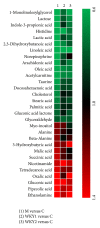Metabolic Signatures of Kidney Yang Deficiency Syndrome and Protective Effects of Two Herbal Extracts in Rats Using GC/TOF MS
- PMID: 24159348
- PMCID: PMC3789486
- DOI: 10.1155/2013/540957
Metabolic Signatures of Kidney Yang Deficiency Syndrome and Protective Effects of Two Herbal Extracts in Rats Using GC/TOF MS
Abstract
Kidney Yang Deficiency Syndrome (KDS-Yang), a typical condition in Chinese medicine, shares similar clinical signs of the glucocorticoid withdrawal syndrome. To date, the underlying mechanism of KDS-Yang has been remained unclear, especially at the metabolic level. In this study, we report a metabolomic profiling study on a classical model of KDS-Yang in rats induced by hydrocortisone injection to characterize the metabolic transformation using gas chromatography/time-of-flight mass spectrometry. WKY1, a polysaccharide extract from Astragalus membranaceus and Lycium barbarum, and WKY2, an aqueous extract from a similar formula containing Astragalus membranaceus, Lycium barbarum, Morinda officinalis, Taraxacum mongolicum, and Cinnamomum cassia presl, were used separately for protective treatments of KDS-Yang. The changes of serum metabolic profiles indicated that significant alterations of key metabolic pathways in response to abrupt hydrocortisone perturbation, including decreased energy metabolism (lactic acid, acetylcarnitine), lipid metabolism (free fatty acids, 1-monolinoleoylglycerol, and cholesterol), gut microbiota metabolism (indole-3-propionic acid), biosynthesis of catecholamine (norepinephrine), and elevated alanine metabolism, were attenuated or normalized with different degrees by the pretreatment of WKY1 or WKY2, which is consistent with the observations in which the two herbal agents could ameliorate biochemical markers of serum cortisone, adrenocorticotropic (ACTH), and urine 17-hydroxycorticosteroids (17-OHCS).
Figures




References
-
- Shen Z. The location of deficiency syndrome of kidney Yang. Chinese Medical Journal. 1999;112(11):973–975. - PubMed
-
- Chen Q. Experimental Methodology of Pharmacological Research in Traditional Chinese Medicine. Beijing, China: People’s Health Publishing House; 1993.
-
- Cao H, Wang ST, Wu LY, Wang XT, Jiang AP. Pharmacological study on Tianxiong (tuber of Aconitum carmichaeli Debx.), a Chinese drug for reinforcing the kidney yang retail in Hong Kong market. China Journal of Chinese Materia Medica. 2001;26(6):369–372. - PubMed
-
- Yang J, Wang Y, Bao Y, Guo J. The total flavones from Semen cuscutae reverse the reduction of testosterone level and the expression of androgen receptor gene in kidney-yang deficient mice. Journal of Ethnopharmacology. 2008;119(1):166–171. - PubMed
-
- Wang CM, Xu SY, Lai S, et al. Curculigo orchioides (Xian Mao) modifies the activity and protein expression of CYP3A in normal and Kidney-Yang Deficiency model rats. Journal of Ethnopharmacology. 2012;144(1):33–38. - PubMed
LinkOut - more resources
Full Text Sources
Other Literature Sources
Miscellaneous

